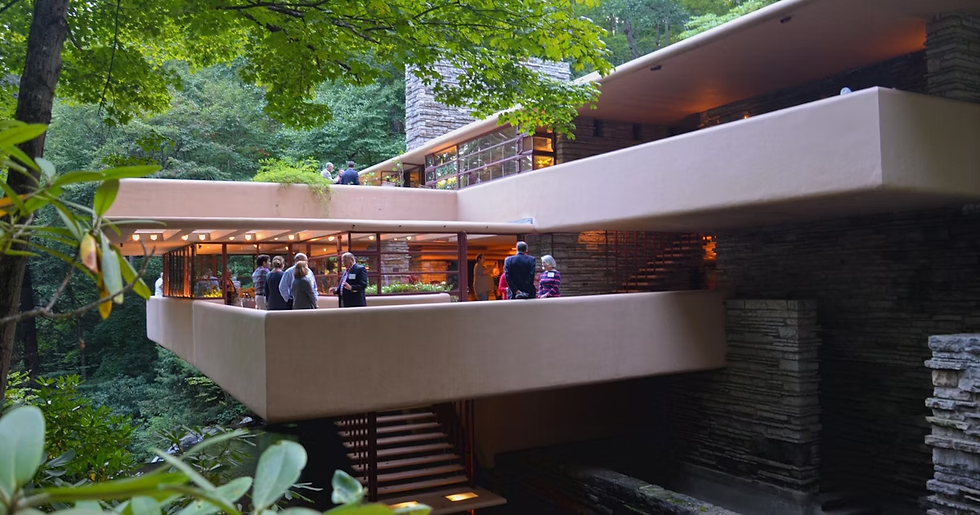Exploring the Architectural Harmony of Fallingwater and Its Integration with Nature
- Journalising Designers
- Jul 13, 2025
- 3 min read
Fallingwater, designed by the renowned architect Frank Lloyd Wright, is often celebrated as one of the most iconic examples of 20th-century architecture. Nestled in the hills of Pennsylvania, this masterpiece showcases an impressive blend of human-made structures with the natural landscape. The innovative design of Fallingwater challenges traditional architectural norms and invites visitors to appreciate the balance between creativity and the environment.
The Architectural Vision of Frank Lloyd Wright
Frank Lloyd Wright envisioned Fallingwater as a residence that blended seamlessly with its surroundings. His philosophy of organic architecture aimed to create harmony between human habitation and the natural world, and Fallingwater exemplifies this vision. The house is notably built over a waterfall, integrating the sound and movement of water into daily life.
Wright's use of local stone, numbering around 2,000 tons, helps connect the home physically and aesthetically to its environment. The design employs cantilevers that allow 30 feet of the structure to extend over the waterfall, providing breathtaking views while minimizing site impact. The result is a stunning architectural feat that enhances the beauty of the natural landscape.

The Significance of Natural Elements
Nature serves a crucial role in the design of Fallingwater. The incorporation of natural elements enhances the living experience for the inhabitants. The soothing sound of the waterfall creates a relaxing atmosphere, while large windows and open spaces ensure that sunlight and fresh air flow freely throughout the home.
Fallingwater features several terraces and balconies that offer various perspectives of the surrounding environment. Visitors can step outside to feel the cool mist from the waterfall, emphasizing Wright's intention to forge a strong connection to nature. By blurring the lines between indoor and outdoor spaces, Fallingwater embodies the philosophy of living harmoniously with the landscape.

The Role of Sustainability in Design
The design principles of Fallingwater align closely with modern sustainability concepts. Wright's commitment to using local materials not only minimized transportation costs but also integrated the home meaningfully into the landscape. Approximately 60% of the structure’s materials were sourced from within a 40-mile radius, a practice that promotes ecological mindfulness.
Fallingwater's lasting legacy highlights the potential for sustainable practices in architecture. It continues to inspire architects and builders aiming to create spaces that honor the environment while ensuring comfort and functionality. As a testament to Wright’s vision, the home encourages new conversations about eco-friendly design in the building industry.
Preservation and Public Engagement
Today, Fallingwater serves both as a private residence and a public museum. Managed by the Western Pennsylvania Conservancy, this architectural gem attracts upwards of 150,000 visitors each year, eager to witness its brilliance firsthand. Ongoing preservation efforts have been essential in maintaining Wright’s original design, ensuring future generations can appreciate its significance.
Educational programs and guided tours provide visitors with valuable insights into the architectural techniques and philosophies behind Fallingwater. These experiences deepen the understanding of this structure in the broader context of American architecture and its relationship to nature.
A Lasting Inspiration
Fallingwater stands as much more than an architectural marvel; it represents a vital connection between human creativity and the natural world. Frank Lloyd Wright’s vision extends beyond aesthetics, sparking ongoing discussions about sustainability and ecological responsibility.
In an increasingly urbanized world, the lessons imparted by Fallingwater resonate more powerfully than ever. It serves as a constant reminder of the importance of integrating nature into our living and working environments. By exploring the architectural harmony of Fallingwater, we can derive inspiration to create spaces that nurture a sense of belonging—both within our homes and within the natural world.
Fallingwater showcases what can be achieved when architecture collaborates with the environment, proving that the finest designs often honor and celebrate the world we inhabit.
